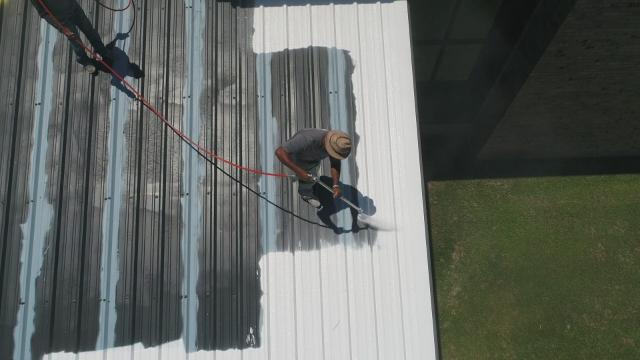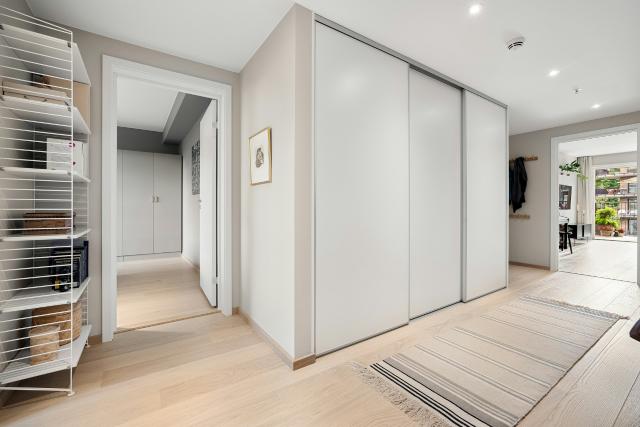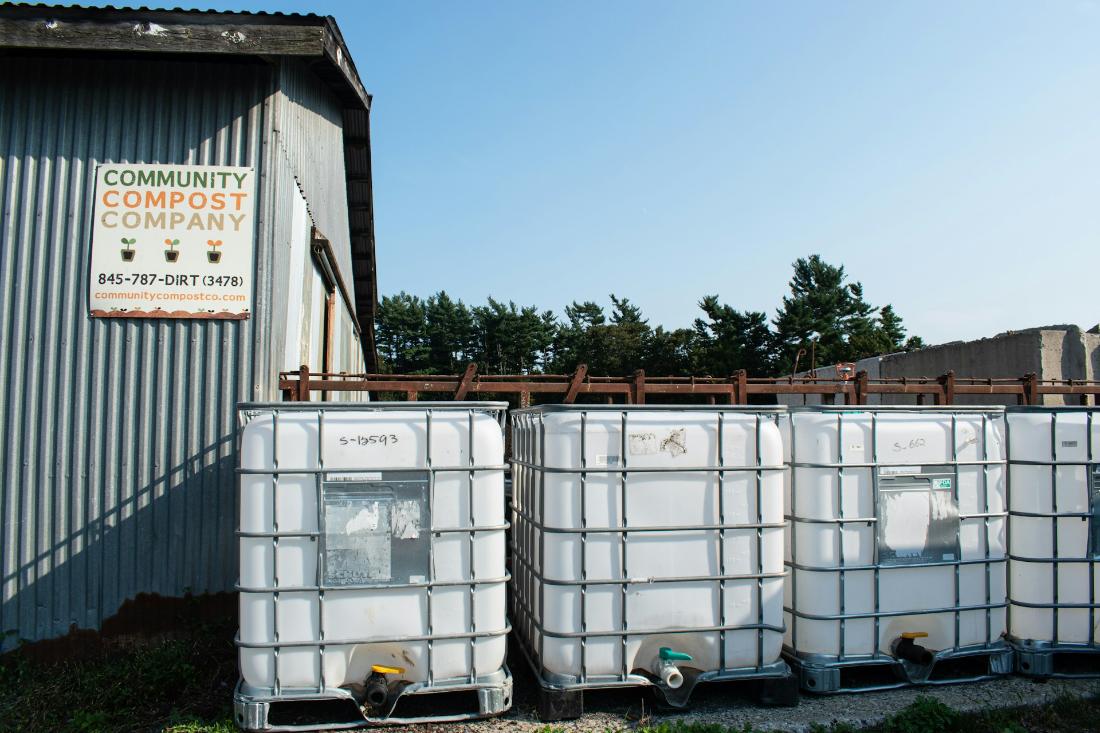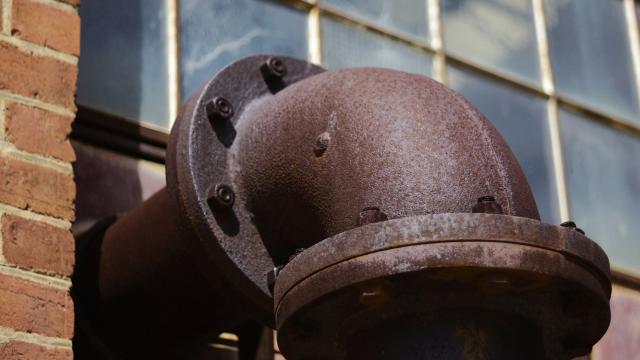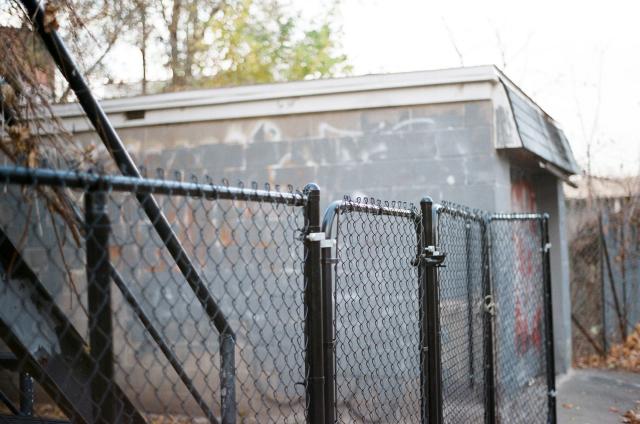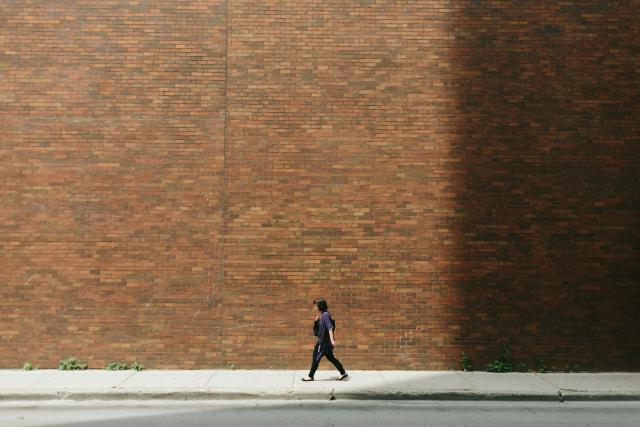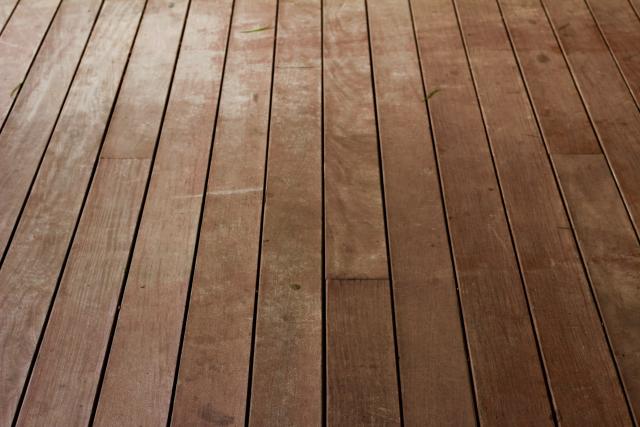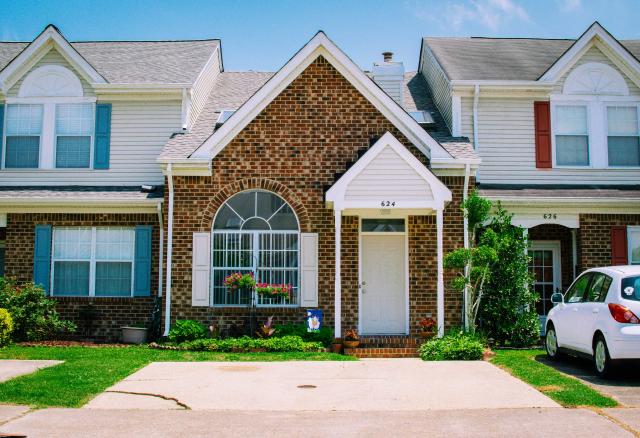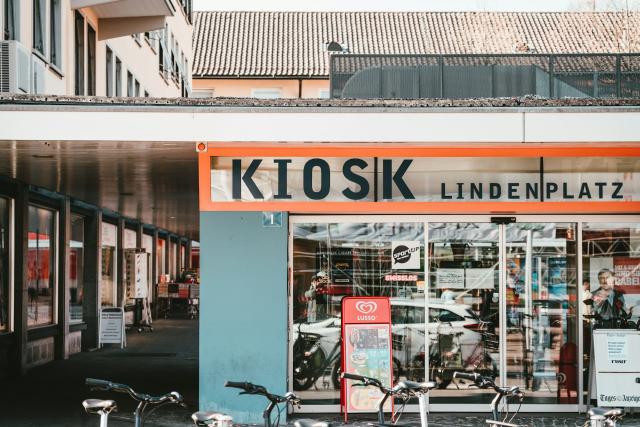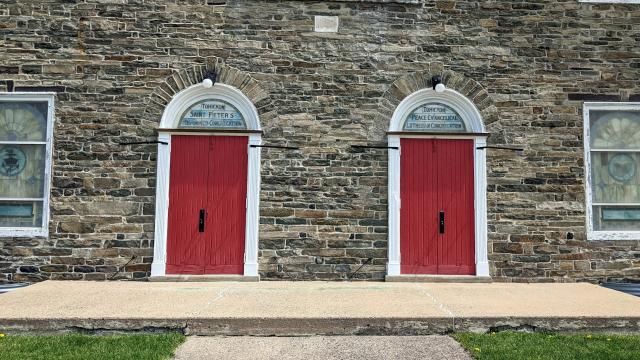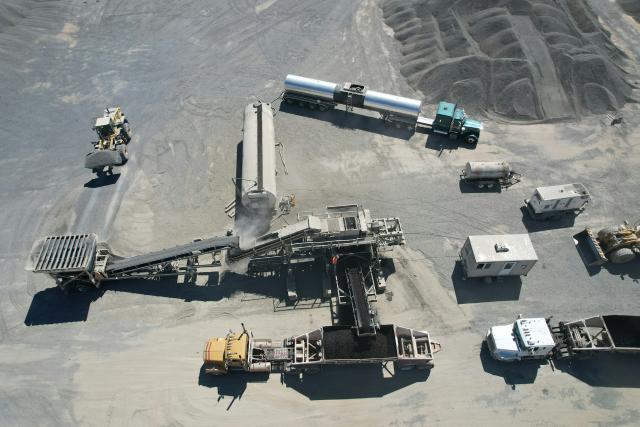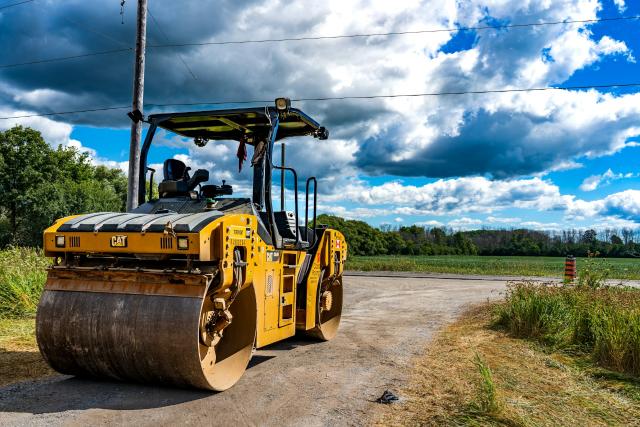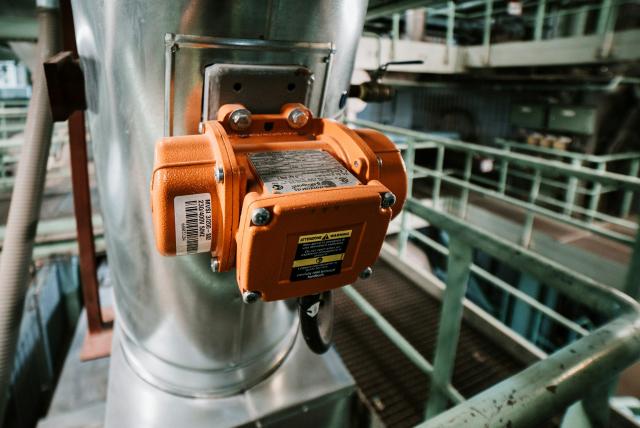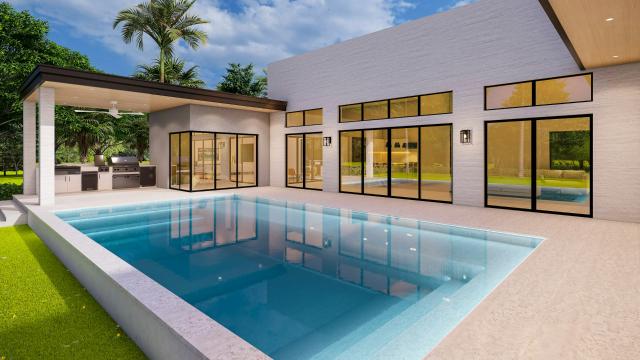Popular Ideas and Designs
Roof coating in industrial construction plays a very important role in terms of ensuring structural integrity, especially when considering harsh weather conditions in Malaysia.
Recently, a major heat reflective roof coating project for metal roof and gutter system in Senai was accomplished. The project highlights the advantages of this specially formulated roof Coating developed in Germany and examines how its impact enhances building efficiency.
Recently, a major heat reflective roof coating project for metal roof and gutter system in Senai was accomplished. The project highlights the advantages of this specially formulated roof Coating developed in Germany and examines how its impact enhances building efficiency.
Is your roof leaking during heavy rain? Are your walls suffering from condensation and mold growth? Do you wish for a cooler, more energy-efficient home or building? If so, waterproof and climate coatings could be the perfect solution for you. Discover how our cutting-edge cool roof coatings can enhance your roof's durability, reduce energy costs, and boost indoor comfort.
Unleash the Power of Waterproof Coating
Leaking roofs can cause significant damage to your property and belongings. Waterproof coatings act as a robust shield, preventing water from seeping through cracks and vulnerable areas. TL Terang Sdn Bhd, a top roof coating expert in Malaysia, provides premium waterproofing solutions ideal for roofs, balconies, basements, and more. Their experienced team will assess your needs and recommend the best coating materials, ensuring long-lasting protection against water damage.In the quiet intimacy of the bedroom, the wardrobe stands as a silent testament to our lives. It holds not just garments, but memories, aspirations, and the daily ritual of preparing to face the world. It is the first place we visit in the morning and the last we close at night. Yet, for many in Malaysia, the standard, boxy built-in or freestanding wardrobe is a constant source of frustration—a jumble of ill-fitting shelves, a graveyard for items lost in deep, dark corners, or a visual clash with the room’s carefully curated aesthetic. This widespread dissatisfaction has given rise to a profound appreciation for the craft of the custom-made wardrobe. This is not merely a furniture purchase; it is a collaborative design journey, an exercise in spatial optimisation, and an investment in a daily life of serene order and personal expression. It represents a shift from making do with what fits the furniture to commissioning furniture that fits your life.
The decision to invest in a custom-made wardrobe in Malaysia is, at its heart, a decision to solve problems that off-the-shelf units cannot address. Malaysian homes, particularly urban apartments and condominiums, often feature bedrooms with unique architectural quirks: awkward alcoves, sloping ceilings, protruding beams, or irregular wall angles. A custom wardrobe is designed to embrace these idiosyncrasies, transforming wasted or challenging spaces into seamless, functional storage. It can be built to ascend to the very ceiling, utilising every available cubic foot for seasonal storage, or be configured to fit perfectly beneath a sloped attic eave. Beyond fitting the room, it is designed to fit the individual. The specialist craftsman understands that a corporate professional’s need for hanging suits differs from a teacher’s need for folded casual wear, which differs again from a collector’s need to display cherished items. The process begins with this fundamental principle: the wardrobe should be a perfect mirror of the owner’s lifestyle, habits, and inventory.
The journey of creating a custom wardrobe is a deeply human and collaborative process, starting with a detailed consultation that feels more like a conversation than a sales pitch. A skilled designer or carpenter will visit the home, tape measure and notebook in hand, but their most important tool is their curiosity. They will ask questions that go far beyond dimensions. How many pairs of shoes do you own, and what are their types—heels, sneakers, boots? Do you prefer to hang most items or fold them? How many full-length dresses, jackets, or baju kurung require long hanging space? What about accessories like belts, ties, watches, or handbags? They will discuss daily routines: is the wardrobe shared, requiring distinct his-and-hers zones? Do you need a dedicated section for work uniforms or gym wear? This investigative dialogue ensures the final design is not just a box with shelves, but a highly personalised storage ecosystem that anticipates and accommodates the real contents of a life, saving time and reducing daily friction.
The decision to invest in a custom-made wardrobe in Malaysia is, at its heart, a decision to solve problems that off-the-shelf units cannot address. Malaysian homes, particularly urban apartments and condominiums, often feature bedrooms with unique architectural quirks: awkward alcoves, sloping ceilings, protruding beams, or irregular wall angles. A custom wardrobe is designed to embrace these idiosyncrasies, transforming wasted or challenging spaces into seamless, functional storage. It can be built to ascend to the very ceiling, utilising every available cubic foot for seasonal storage, or be configured to fit perfectly beneath a sloped attic eave. Beyond fitting the room, it is designed to fit the individual. The specialist craftsman understands that a corporate professional’s need for hanging suits differs from a teacher’s need for folded casual wear, which differs again from a collector’s need to display cherished items. The process begins with this fundamental principle: the wardrobe should be a perfect mirror of the owner’s lifestyle, habits, and inventory.
The journey of creating a custom wardrobe is a deeply human and collaborative process, starting with a detailed consultation that feels more like a conversation than a sales pitch. A skilled designer or carpenter will visit the home, tape measure and notebook in hand, but their most important tool is their curiosity. They will ask questions that go far beyond dimensions. How many pairs of shoes do you own, and what are their types—heels, sneakers, boots? Do you prefer to hang most items or fold them? How many full-length dresses, jackets, or baju kurung require long hanging space? What about accessories like belts, ties, watches, or handbags? They will discuss daily routines: is the wardrobe shared, requiring distinct his-and-hers zones? Do you need a dedicated section for work uniforms or gym wear? This investigative dialogue ensures the final design is not just a box with shelves, but a highly personalised storage ecosystem that anticipates and accommodates the real contents of a life, saving time and reducing daily friction.
In the rhythm of Malaysian life, from the first morning shower in a high-rise apartment to the steady production line of a Johor factory, there is a silent, steadfast presence holding the key to continuity: the storage tank. Whether perched on a rooftop, buried underground, or standing sentinel in an industrial yard, these vessels are the guardians of our most essential resources—clean water, wastewater, chemicals, and fuel. We take their flawless function for granted until the day a crack appears, a leak drips, or a strange taste hints at contamination. In that moment, the critical role of the tank repair specialist comes sharply into focus. This professional is far more than a technician with a welding torch; they are a materials scientist, a structural diagnostician, a specialist in hazardous containment, and a guardian against waste, pollution, and operational shutdown. Their work ensures the vessels that sustain our homes, businesses, and industries remain secure, efficient, and intact.
The need for specialised tank repair in Malaysia is amplified by a demanding environment and a diverse industrial landscape. The relentless tropical cycle of intense sun, heavy rain, and pervasive humidity accelerates the deterioration of many materials. Ultraviolet radiation degrades plastic and coatings, while constant moisture fosters corrosion in metal tanks, particularly in coastal areas where salt spray compounds the attack. Beyond the climate, the very contents stored apply unique stresses. Water tanks, both domestic and commercial, face challenges from sediment buildup, biofilm growth (the slippery layer often felt inside), and corrosion from varying water chemistries. For industrial tanks holding chemicals, acids, alkalis, or fuels, the threats are more acute, involving chemical corrosion, structural fatigue from temperature fluctuations, and the ever-present risk of hazardous leaks. The tank repair specialist operates within this complex matrix of material science, chemical interaction, and structural integrity, where a standard patch is never enough; the solution must be engineered to address the specific cause of failure.
The specialist’s process begins with a comprehensive and safety-conscious diagnosis, a step that is as much about investigation as it is about precaution. Before any repair can be contemplated, the tank must be properly isolated, drained, cleaned, and ventilated—a critical procedure, especially for tanks that have contained fuel or volatile chemicals. Residual fumes pose a severe explosion risk, and a reputable specialist adheres to strict confined space entry protocols and gas testing. Once safe access is granted, the real detective work starts. Using visual inspection, thickness gauges (to measure metal loss), and sometimes even non-destructive testing methods like ultrasonic testing, the specialist maps the extent of the damage. Is the corrosion generalised or localised to a weld seam or the tank bottom where water and sediment settle? Is the crack a result of structural stress, material fatigue, or foundation settlement? For fibreglass-reinforced plastic (FRP) or polyethylene tanks, they look for signs of UV degradation, cracking from impact, or chemical attack that has made the material brittle. This meticulous assessment determines whether a repair is viable and what methodology will provide a permanent, safe solution, not just a temporary cover-up.
The need for specialised tank repair in Malaysia is amplified by a demanding environment and a diverse industrial landscape. The relentless tropical cycle of intense sun, heavy rain, and pervasive humidity accelerates the deterioration of many materials. Ultraviolet radiation degrades plastic and coatings, while constant moisture fosters corrosion in metal tanks, particularly in coastal areas where salt spray compounds the attack. Beyond the climate, the very contents stored apply unique stresses. Water tanks, both domestic and commercial, face challenges from sediment buildup, biofilm growth (the slippery layer often felt inside), and corrosion from varying water chemistries. For industrial tanks holding chemicals, acids, alkalis, or fuels, the threats are more acute, involving chemical corrosion, structural fatigue from temperature fluctuations, and the ever-present risk of hazardous leaks. The tank repair specialist operates within this complex matrix of material science, chemical interaction, and structural integrity, where a standard patch is never enough; the solution must be engineered to address the specific cause of failure.
The specialist’s process begins with a comprehensive and safety-conscious diagnosis, a step that is as much about investigation as it is about precaution. Before any repair can be contemplated, the tank must be properly isolated, drained, cleaned, and ventilated—a critical procedure, especially for tanks that have contained fuel or volatile chemicals. Residual fumes pose a severe explosion risk, and a reputable specialist adheres to strict confined space entry protocols and gas testing. Once safe access is granted, the real detective work starts. Using visual inspection, thickness gauges (to measure metal loss), and sometimes even non-destructive testing methods like ultrasonic testing, the specialist maps the extent of the damage. Is the corrosion generalised or localised to a weld seam or the tank bottom where water and sediment settle? Is the crack a result of structural stress, material fatigue, or foundation settlement? For fibreglass-reinforced plastic (FRP) or polyethylene tanks, they look for signs of UV degradation, cracking from impact, or chemical attack that has made the material brittle. This meticulous assessment determines whether a repair is viable and what methodology will provide a permanent, safe solution, not just a temporary cover-up.
In the hidden veins of every Malaysian building—be it a towering condominium, a bustling restaurant, or a family terrace house—flows the lifeblood of modern sanitation: water in, and waste out. We rarely give this intricate, subterranean network a second thought until the moment it rebels. The gurgle of a sink refusing to drain, the unpleasant aroma rising from a floor trap, or the heart-sinking sight of water backing up into a shower stall are visceral reminders of our dependence on these unseen channels. In these moments of domestic crisis, a unique professional becomes the essential hero: the pipe cleaning specialist. This expert is far more than a unclogger of drains; they are a diagnostician of hidden systems, a hygienic engineer, and a guardian of public health, wielding technology and expertise to restore the vital flow that our daily lives depend upon.
The need for pipe cleaning specialists in Malaysia is deeply intertwined with the nation's climate, cuisine, and urban lifestyle. The tropical environment accelerates the breakdown of some materials and promotes the rapid growth of organic matter. Combine this with culinary traditions rich in oils, starches, and fibrous materials, and the common practice of disposing of food scraps and cooking grease down kitchen sinks, and you have a perfect recipe for pipe blockages. In older properties, the challenge is compounded by ageing infrastructure—clay pipes that can crack and root-invaded, or galvanised iron pipes succumbing to decades of rust and scale buildup. The specialist operates in this complex landscape, where each blockage tells a story of usage, material failure, and time. Their work is not a luxury but a critical component of property maintenance, preventing minor inconveniences from escalating into major sanitation emergencies and structural damage.
When a homeowner or business manager faces a blockage, the first and most critical role of the specialist is that of a precise diagnostician. The symptom—a slow-draining sink—is common, but the cause could be anything from a simple hair clog in the U-bend to a collapsed sewer line deep under the foundation. A seasoned specialist begins with a methodical investigation. They ask detailed questions about the symptoms: Is only one fixture affected, or are multiple drains backing up? Does flushing a toilet cause water to rise in a shower drain? This interrogation narrows down whether the problem is isolated to a single branch line or indicates a blockage in the main soil stack or external sewer. They then employ tools of the trade to visualize the unseen. A simple plumber’s auger or hand-cranked drain snake can address minor, localised clogs. For more mysterious or persistent issues, the true technological prowess comes into play with Closed-Circuit Television (CCTV) drain camera inspection.
The need for pipe cleaning specialists in Malaysia is deeply intertwined with the nation's climate, cuisine, and urban lifestyle. The tropical environment accelerates the breakdown of some materials and promotes the rapid growth of organic matter. Combine this with culinary traditions rich in oils, starches, and fibrous materials, and the common practice of disposing of food scraps and cooking grease down kitchen sinks, and you have a perfect recipe for pipe blockages. In older properties, the challenge is compounded by ageing infrastructure—clay pipes that can crack and root-invaded, or galvanised iron pipes succumbing to decades of rust and scale buildup. The specialist operates in this complex landscape, where each blockage tells a story of usage, material failure, and time. Their work is not a luxury but a critical component of property maintenance, preventing minor inconveniences from escalating into major sanitation emergencies and structural damage.
When a homeowner or business manager faces a blockage, the first and most critical role of the specialist is that of a precise diagnostician. The symptom—a slow-draining sink—is common, but the cause could be anything from a simple hair clog in the U-bend to a collapsed sewer line deep under the foundation. A seasoned specialist begins with a methodical investigation. They ask detailed questions about the symptoms: Is only one fixture affected, or are multiple drains backing up? Does flushing a toilet cause water to rise in a shower drain? This interrogation narrows down whether the problem is isolated to a single branch line or indicates a blockage in the main soil stack or external sewer. They then employ tools of the trade to visualize the unseen. A simple plumber’s auger or hand-cranked drain snake can address minor, localised clogs. For more mysterious or persistent issues, the true technological prowess comes into play with Closed-Circuit Television (CCTV) drain camera inspection.
Structure
Fencing Specialist in Malaysia: Defining Boundaries, Crafting Curb Appeal, and Building Security
In the rhythm of Malaysian life, the transition from the public street to the private home is a moment marked by a simple, profound act: the opening of a gate. This threshold, and the fence that frames it, is far more than a physical boundary. It is a silent declaration of sanctuary, a backdrop for childhood games visible from the kitchen window, and the first impression that shapes a neighbour’s perception. The professional who masters the art and science of this essential perimeter is the fencing specialist. This expert is more than a builder of barriers; they are a consultant on security, an artist in metal and wood, a strategist for privacy, and a practical problem-solver who understands that a fence must withstand both tropical storms and the test of time. Their work shapes the very character of a property, balancing the need for security with the desire for beauty and community connection.
The role of a fence in the Malaysian context is complex and deeply layered, answering to a spectrum of human needs. Foremost is security and peace of mind. In both bustling urban neighborhoods and quieter suburban areas, a robust fence acts as a psychological and physical deterrent, defining private property clearly and adding a critical layer of difficulty for unwanted intrusion. Yet, security need not mean fortress-like isolation. A well-designed fence provides a sense of enclosure and privacy, creating an outdoor living room where families can relax, children can play, and meals can be enjoyed al fresco without feeling on display. This privacy is especially precious in densely packed residential areas. Simultaneously, a fence must manage its relationship with the surrounding environment. It should offer protection from stray animals, contain pets safely, and buffer street noise and dust. Perhaps most subtly, a fence makes a powerful aesthetic statement. It frames the property, complements the architectural style of the house, and contributes significantly to the streetscape’s overall charm and order. The fencing specialist’s first task is to listen and interpret how these priorities—security, privacy, function, and beauty—are weighted for each homeowner, crafting a solution that harmonises these often-competing demands.
The journey with a specialist begins on-site, with a consultation that considers the land itself. They assess the topography: is the ground level, or does it slope, requiring stepped or racked fence panels? They examine soil conditions, as this will determine the depth and method of post-setting, crucial for stability in soft or clay-heavy soils common in Malaysia. They note drainage patterns to avoid trapping water against the fence line, which accelerates rot and rust. They also consider environmental exposure: will the fence face the full brunt of the afternoon sun and seasonal rains, or is it sheltered? This initial survey is diagnostic, informing every subsequent decision about materials, foundations, and design to ensure the fence is built not just for today, but for decades of Malaysian weather.
The role of a fence in the Malaysian context is complex and deeply layered, answering to a spectrum of human needs. Foremost is security and peace of mind. In both bustling urban neighborhoods and quieter suburban areas, a robust fence acts as a psychological and physical deterrent, defining private property clearly and adding a critical layer of difficulty for unwanted intrusion. Yet, security need not mean fortress-like isolation. A well-designed fence provides a sense of enclosure and privacy, creating an outdoor living room where families can relax, children can play, and meals can be enjoyed al fresco without feeling on display. This privacy is especially precious in densely packed residential areas. Simultaneously, a fence must manage its relationship with the surrounding environment. It should offer protection from stray animals, contain pets safely, and buffer street noise and dust. Perhaps most subtly, a fence makes a powerful aesthetic statement. It frames the property, complements the architectural style of the house, and contributes significantly to the streetscape’s overall charm and order. The fencing specialist’s first task is to listen and interpret how these priorities—security, privacy, function, and beauty—are weighted for each homeowner, crafting a solution that harmonises these often-competing demands.
The journey with a specialist begins on-site, with a consultation that considers the land itself. They assess the topography: is the ground level, or does it slope, requiring stepped or racked fence panels? They examine soil conditions, as this will determine the depth and method of post-setting, crucial for stability in soft or clay-heavy soils common in Malaysia. They note drainage patterns to avoid trapping water against the fence line, which accelerates rot and rust. They also consider environmental exposure: will the fence face the full brunt of the afternoon sun and seasonal rains, or is it sheltered? This initial survey is diagnostic, informing every subsequent decision about materials, foundations, and design to ensure the fence is built not just for today, but for decades of Malaysian weather.
In the quiet moments of a Malaysian evening, as the ceiling fan turns with a gentle hum and the soft glow of a recessed light illuminates a room, it’s easy to overlook the fifth wall—the ceiling. Yet, this often-unnoticed plane is a silent orchestrator of our domestic and commercial environments. It defines the volume of a space, controls the quality of light and sound, conceals a tangle of essential services, and provides a crucial barrier against the heat gathering at the apex of every building. The professional who masters this complex overhead realm is the ceiling specialist. Far more than an installer of plasterboard, this expert is a designer of spatial perception, an engineer of acoustics and climate, and a meticulous problem-solver who works to ensure the space above our heads is one of order, comfort, and quiet beauty. Their craft is fundamental to creating interiors that feel complete, considered, and calmly contained.
The significance of a well-executed ceiling in the Malaysian context cannot be overstated, as it directly confronts the nation’s most pressing environmental challenge: heat. Hot air naturally rises, and in a tropical climate, a poorly designed ceiling allows this accumulated heat to radiate back into the living space, forcing air conditioning systems to work harder and increasing energy costs dramatically. The ceiling specialist’s first duty is therefore one of thermal management. They are experts in installing insulation materials—from reflective foil barriers to bulk insulation like fibreglass or rockwool—within the ceiling cavity. This creates a critical thermal break, dramatically slowing the transfer of heat from the sun-baked roof into the room below. For spaces with exposed roofs, such as warehouses or industrial-chic lofts, they apply specialised insulating paints or install thermally broken ceiling systems. This focus on thermal performance is not an add-on but a core principle, making the ceiling a key component in the fight for energy efficiency and indoor comfort.
Beyond climate control, the ceiling is the primary canvas for managing a room’s artificial environment. It houses the infrastructure of modern living. Electrical conduits, air-conditioning ducting, water pipes, data cables, and sprinkler systems all converge in the space above a false ceiling. A ceiling specialist is the maestro who orchestrates this hidden chaos. They work in close consultation with electricians, HVAC engineers, and IT teams during the planning stage to design a ceiling framework that accommodates all these services while maintaining necessary clearances and access points. They then build the suspended grid—typically from galvanised steel channels—with precise levelling to create a perfectly flat plane from which the ceiling panels will hang. This structural skeleton must be robust enough to support the weight of light fixtures, air-con diffusers, and sometimes even maintenance personnel, all while complying with stringent fire safety regulations that dictate the use of specific materials and assembly methods in commercial buildings.
The significance of a well-executed ceiling in the Malaysian context cannot be overstated, as it directly confronts the nation’s most pressing environmental challenge: heat. Hot air naturally rises, and in a tropical climate, a poorly designed ceiling allows this accumulated heat to radiate back into the living space, forcing air conditioning systems to work harder and increasing energy costs dramatically. The ceiling specialist’s first duty is therefore one of thermal management. They are experts in installing insulation materials—from reflective foil barriers to bulk insulation like fibreglass or rockwool—within the ceiling cavity. This creates a critical thermal break, dramatically slowing the transfer of heat from the sun-baked roof into the room below. For spaces with exposed roofs, such as warehouses or industrial-chic lofts, they apply specialised insulating paints or install thermally broken ceiling systems. This focus on thermal performance is not an add-on but a core principle, making the ceiling a key component in the fight for energy efficiency and indoor comfort.
Beyond climate control, the ceiling is the primary canvas for managing a room’s artificial environment. It houses the infrastructure of modern living. Electrical conduits, air-conditioning ducting, water pipes, data cables, and sprinkler systems all converge in the space above a false ceiling. A ceiling specialist is the maestro who orchestrates this hidden chaos. They work in close consultation with electricians, HVAC engineers, and IT teams during the planning stage to design a ceiling framework that accommodates all these services while maintaining necessary clearances and access points. They then build the suspended grid—typically from galvanised steel channels—with precise levelling to create a perfectly flat plane from which the ceiling panels will hang. This structural skeleton must be robust enough to support the weight of light fixtures, air-con diffusers, and sometimes even maintenance personnel, all while complying with stringent fire safety regulations that dictate the use of specific materials and assembly methods in commercial buildings.
In Malaysia, where the heat of the day gives way to the intimate comfort of home, our walls are more than mere dividers of space. They are the backdrop to family photographs, the canvas for a child’s first scribbles, the silent witness to conversations and celebrations. They define the character of a room, influence its light and acoustics, and stand as the first line of defence against the external elements. Yet, their true potential is often unlocked not by the architect who conceived them, but by the craftsman who finishes them: the wall specialist. This professional is a master of surface, a problem-solver for the pervasive challenges of the tropical climate, and an artist whose medium is plaster, paint, and texture. Their work transforms bare structures into lived-in spaces, ensuring these vertical planes are not only beautiful but also durable, clean, and fundamentally sound.
The relationship between a Malaysian building and its walls is a constant negotiation with a demanding environment. Humidity is the ever-present antagonist, capable of transforming a seemingly perfect plaster job into a network of hairline cracks or encouraging a bloom of unsightly mould. The intense equatorial sun can fade the most vibrant paint in a matter of seasons. Seasonal rains test the integrity of external renders, seeking out microscopic weaknesses. A true wall specialist approaches their craft with this environmental reality at the forefront. Their expertise lies not just in application, but in preparation and prevention. They understand that the longevity of a beautiful wall is determined long before the final coat is applied, beginning with the correct selection of materials designed to breathe, flex, and resist the specific assaults of the local climate. Their role is to build a resilient skin for the building, one that protects the interior sanctuary while expressing the desired aesthetic.
The journey of perfecting a wall begins with diagnosis and repair, where the specialist acts as a forensic physician for the building’s skin. Homeowners often call upon them when symptoms appear: ominous cracks spiderwebbing from a corner, damp patches spreading like shadows, or the crumbling of old plaster. A specialist’s first task is to identify the root cause, not merely cover the symptom. A crack might be superficial, stemming from the natural curing of plaster, or it could be a sign of more serious structural movement. A damp patch might indicate a leaking pipe, failing external waterproofing, or simply condensation due to poor ventilation. Using their experience, they trace the problem to its source. Repair then becomes a surgical process. They might need to hack away damaged plaster back to a sound substrate, apply a waterproofing slurry or bonding agent, and meticulously rebuild the surface in layers. This foundational work, though unseen in the final result, is the critical step that ensures a repair is permanent, not a temporary camouflage.
The relationship between a Malaysian building and its walls is a constant negotiation with a demanding environment. Humidity is the ever-present antagonist, capable of transforming a seemingly perfect plaster job into a network of hairline cracks or encouraging a bloom of unsightly mould. The intense equatorial sun can fade the most vibrant paint in a matter of seasons. Seasonal rains test the integrity of external renders, seeking out microscopic weaknesses. A true wall specialist approaches their craft with this environmental reality at the forefront. Their expertise lies not just in application, but in preparation and prevention. They understand that the longevity of a beautiful wall is determined long before the final coat is applied, beginning with the correct selection of materials designed to breathe, flex, and resist the specific assaults of the local climate. Their role is to build a resilient skin for the building, one that protects the interior sanctuary while expressing the desired aesthetic.
The journey of perfecting a wall begins with diagnosis and repair, where the specialist acts as a forensic physician for the building’s skin. Homeowners often call upon them when symptoms appear: ominous cracks spiderwebbing from a corner, damp patches spreading like shadows, or the crumbling of old plaster. A specialist’s first task is to identify the root cause, not merely cover the symptom. A crack might be superficial, stemming from the natural curing of plaster, or it could be a sign of more serious structural movement. A damp patch might indicate a leaking pipe, failing external waterproofing, or simply condensation due to poor ventilation. Using their experience, they trace the problem to its source. Repair then becomes a surgical process. They might need to hack away damaged plaster back to a sound substrate, apply a waterproofing slurry or bonding agent, and meticulously rebuild the surface in layers. This foundational work, though unseen in the final result, is the critical step that ensures a repair is permanent, not a temporary camouflage.
From the first cool touch of polished marble on a hot afternoon to the gentle give of a quality carpet underfoot at dawn, the floor is our most constant physical connection to the spaces we inhabit. In Malaysia, where homes are sanctuaries from the tropical bustle and businesses strive to make a lasting impression, this foundational surface is more than mere substrate; it is a statement of style, a determinant of comfort, and a critical component of a building’s functionality. The professional who masters this domain is the floor specialist. This expert transcends the role of a simple installer or tile supplier. They are material scientists, acoustical engineers, artists, and project managers rolled into one, dedicated to transforming the very plane upon which Malaysian life unfolds. Their work requires a deep understanding of local climate, lifestyle, and the subtle interplay between beauty and resilience.
The journey with a floor specialist begins with a fundamental appreciation for the floor’s multifaceted role. A floor must be, above all, functional and durable. In a Malaysian home, it faces a relentless cycle of humidity, tracked-in rain, occasional spills, and the comings and goings of busy family life. It must withstand expansion and contraction without warping, resist moisture without deteriorating, and endure daily wear without quickly losing its lustre. Beyond this, the floor is a primary driver of a room's aesthetic and atmosphere. Its colour, texture, and reflectivity influence the perception of space, light, and temperature. A dark, glossy tile can feel cool and modern but may make a small room feel cavernous; a light-toned, textured wood can bring warmth and a sense of airiness. Furthermore, the floor plays a crucial role in acoustic comfort, especially in high-rise condominiums where impact noise from footsteps is a major concern. The specialist must balance all these demands—durability, aesthetics, acoustics, thermal feel, and budget—to guide clients toward a choice that harmonises with their life, not just their décor.
The world of flooring materials is vast, and a seasoned specialist serves as an indispensable guide through this landscape, matching the unique properties of each option to the client's reality. Ceramic and porcelain tiles reign supreme in many Malaysian homes for their exceptional moisture resistance, cool feel, and easy maintenance. The specialist explains the difference between the two, the importance of slip resistance (especially for wet areas), and the advancements in digital printing that allow for stunning wood, stone, and abstract designs. For those craving natural warmth, the specialist delves into the realm of timber. They distinguish between solid hardwood, which can be sanded and refinished multiple times but is sensitive to humidity, and the more dimensionally stable engineered wood, which offers a real wood surface over a plywood core. They also present luxury vinyl plank (LVP) or tile (LVT), a technological marvel that convincingly mimics wood or stone while being completely waterproof, scratch-resistant, and comfortable underfoot—a revolutionary choice for active families.
The journey with a floor specialist begins with a fundamental appreciation for the floor’s multifaceted role. A floor must be, above all, functional and durable. In a Malaysian home, it faces a relentless cycle of humidity, tracked-in rain, occasional spills, and the comings and goings of busy family life. It must withstand expansion and contraction without warping, resist moisture without deteriorating, and endure daily wear without quickly losing its lustre. Beyond this, the floor is a primary driver of a room's aesthetic and atmosphere. Its colour, texture, and reflectivity influence the perception of space, light, and temperature. A dark, glossy tile can feel cool and modern but may make a small room feel cavernous; a light-toned, textured wood can bring warmth and a sense of airiness. Furthermore, the floor plays a crucial role in acoustic comfort, especially in high-rise condominiums where impact noise from footsteps is a major concern. The specialist must balance all these demands—durability, aesthetics, acoustics, thermal feel, and budget—to guide clients toward a choice that harmonises with their life, not just their décor.
The world of flooring materials is vast, and a seasoned specialist serves as an indispensable guide through this landscape, matching the unique properties of each option to the client's reality. Ceramic and porcelain tiles reign supreme in many Malaysian homes for their exceptional moisture resistance, cool feel, and easy maintenance. The specialist explains the difference between the two, the importance of slip resistance (especially for wet areas), and the advancements in digital printing that allow for stunning wood, stone, and abstract designs. For those craving natural warmth, the specialist delves into the realm of timber. They distinguish between solid hardwood, which can be sanded and refinished multiple times but is sensitive to humidity, and the more dimensionally stable engineered wood, which offers a real wood surface over a plywood core. They also present luxury vinyl plank (LVP) or tile (LVT), a technological marvel that convincingly mimics wood or stone while being completely waterproof, scratch-resistant, and comfortable underfoot—a revolutionary choice for active families.
In Malaysia, the rain has a distinct language. It begins as a whisper on leaves, builds to a steady drumroll, and can crescendo into a torrential roar that tests the very integrity of every structure it meets. It is during these symphonies of the monsoon that we are most acutely aware of our shelter, and of the single, most critical element that stands between our comfort and the chaos of the elements: the roof. More than just the topmost layer of a building, the roof is a complex, engineered system, a silent guardian against a relentless tropical climate. The mastery of this system belongs to a unique professional: the roof specialist in Malaysia. This individual is far more than a contractor who lays tiles; they are a diagnostician, a materials scientist, a thermal engineer, and a restorer of peace of mind, tasked with preserving the integrity of everything that lies beneath.
The Malaysian roof faces a triad of formidable adversaries: sun, rain, and wind. The tropical sun beats down with intense UV radiation, degrading materials, fading colours, and driving heat deep into the building structure. This is followed by sudden, heavy downpours that test waterproofing to its absolute limit, seeking out the smallest weakness to exploit. Seasonal winds and the occasional severe storm apply lifting and shearing forces that can tear away poorly secured materials. A roof specialist approaches their craft with a deep respect for these forces. Their work is not merely about coverage; it is about creating a high-performance barrier system. This system must be designed to shed water swiftly and completely, reflect solar radiation to reduce heat gain, possess the structural integrity to resist wind uplift, and be built with materials capable of weathering decades of this cyclic punishment. Understanding this dynamic interplay is the foundation of all specialist work, from a new installation on a suburban terrace house to the repair of a centuries-old heritage roof in Penang.
The journey of a roof specialist with a homeowner often begins not on a sunny planning day, but in a moment of distress: a persistent leak staining a ceiling, a dislodged tile after a storm, or the worrying sag of a roof line. The specialist’s first and perhaps most valuable role is that of a forensic diagnostician. Armed with experience, they climb into the attic space or onto the roof itself, reading the story written in water stains, mould patterns, and wood rot. They identify the true source of a leak, which is rarely directly above the interior stain due to water travelling along rafters. They assess the condition of the underlying structure—the timber kasau (rafters) and alang (purlins)—checking for insect damage or decay that compromises strength. They inspect the state of the sarking or roof underlayment, a critical secondary barrier often overlooked. This comprehensive diagnosis is crucial; treating only the symptom (a single broken tile) without addressing the underlying cause (failing underlayment or inadequate ventilation) is a temporary fix at best. The specialist provides a clear, honest assessment, outlining not just what is broken, but why it broke, and presenting a prioritized plan to restore integrity.
The Malaysian roof faces a triad of formidable adversaries: sun, rain, and wind. The tropical sun beats down with intense UV radiation, degrading materials, fading colours, and driving heat deep into the building structure. This is followed by sudden, heavy downpours that test waterproofing to its absolute limit, seeking out the smallest weakness to exploit. Seasonal winds and the occasional severe storm apply lifting and shearing forces that can tear away poorly secured materials. A roof specialist approaches their craft with a deep respect for these forces. Their work is not merely about coverage; it is about creating a high-performance barrier system. This system must be designed to shed water swiftly and completely, reflect solar radiation to reduce heat gain, possess the structural integrity to resist wind uplift, and be built with materials capable of weathering decades of this cyclic punishment. Understanding this dynamic interplay is the foundation of all specialist work, from a new installation on a suburban terrace house to the repair of a centuries-old heritage roof in Penang.
The journey of a roof specialist with a homeowner often begins not on a sunny planning day, but in a moment of distress: a persistent leak staining a ceiling, a dislodged tile after a storm, or the worrying sag of a roof line. The specialist’s first and perhaps most valuable role is that of a forensic diagnostician. Armed with experience, they climb into the attic space or onto the roof itself, reading the story written in water stains, mould patterns, and wood rot. They identify the true source of a leak, which is rarely directly above the interior stain due to water travelling along rafters. They assess the condition of the underlying structure—the timber kasau (rafters) and alang (purlins)—checking for insect damage or decay that compromises strength. They inspect the state of the sarking or roof underlayment, a critical secondary barrier often overlooked. This comprehensive diagnosis is crucial; treating only the symptom (a single broken tile) without addressing the underlying cause (failing underlayment or inadequate ventilation) is a temporary fix at best. The specialist provides a clear, honest assessment, outlining not just what is broken, but why it broke, and presenting a prioritized plan to restore integrity.
In the heart of a Malaysian home, the kitchen holds a sacred space. It is where the aromatic sizzle of garlic and shallots forms the base of a family curry, where the steady simmer of a broth speaks of care, and where generations gather. Yet, this crucible of culture and connection also generates an invisible byproduct: a complex plume of smoke, steam, grease, and odours. Left unchecked, this plume would coat every surface, irritate every eye, and linger in every breath. The silent, steadfast guardian that preserves the sanctity of this space is the kitchen chimney, and the experts who ensure its flawless operation are chimney specialists. In a nation where high-rise living meets a culinary tradition rich in frying, steaming, and stir-frying, these professionals are not mere installers; they are essential engineers of indoor air quality, protectors of property, and unsung contributors to the nation’s health and domestic harmony.
The role of a chimney, or kitchen hood, in the Malaysian context is profoundly important and distinct from its Western counterpart. While fireplaces are rare, the culinary output is immense. A chimney’s primary mission is threefold: extraction, filtration, and ventilation. During cooking, it acts as a diligent extractor, actively pulling upwards the hot air, moisture, and airborne contaminants generated at the stove. This immediate capture is crucial; it prevents these elements from dispersing throughout the home, where they can condense on walls, seep into curtains, and settle into furniture, causing gradual but persistent damage and creating a lingering, stale odour. Beyond mere extraction, a modern chimney is a filtration plant. As the air is drawn in, it passes through a series of filters—typically aluminium mesh to trap grease and activated charcoal to neutralise odours—scrubbing it clean before it is either recirculated back into the kitchen or expelled outside. This process is fundamental to maintaining a clean, fresh, and healthy living environment, especially in compact urban apartments where space is limited and air circulation can be challenging.
A chimney specialist’s work begins long before a unit is mounted on the wall. It starts with a critical site survey and consultation, a process that demands a blend of technical knowledge and practical wisdom. The specialist assesses the heart of the home: the kitchen layout. They evaluate the type and power of the cooking hob—a high-BTU wok burner demands vastly different extraction power than a standard induction cooktop. They measure the volume of the kitchen space to calculate the necessary Air Cubic Feet per Minute (ACFM) rating, ensuring the chimney has the muscle to handle the air volume effectively. Crucially, they determine the ducting pathway. Can the fumes be vented directly to the outside via a short, straight duct? Or, as is common in many high-rise apartments with centralised ducts, is a recirculation (ductless) model the only feasible option? This initial diagnosis is vital, as installing an underpowered chimney or choosing the wrong type is a costly mistake that leads to poor performance, wasted energy, and homeowner frustration. The specialist acts as a guide, translating the homeowner’s cooking habits and spatial constraints into a technical specification for the perfect appliance.
The role of a chimney, or kitchen hood, in the Malaysian context is profoundly important and distinct from its Western counterpart. While fireplaces are rare, the culinary output is immense. A chimney’s primary mission is threefold: extraction, filtration, and ventilation. During cooking, it acts as a diligent extractor, actively pulling upwards the hot air, moisture, and airborne contaminants generated at the stove. This immediate capture is crucial; it prevents these elements from dispersing throughout the home, where they can condense on walls, seep into curtains, and settle into furniture, causing gradual but persistent damage and creating a lingering, stale odour. Beyond mere extraction, a modern chimney is a filtration plant. As the air is drawn in, it passes through a series of filters—typically aluminium mesh to trap grease and activated charcoal to neutralise odours—scrubbing it clean before it is either recirculated back into the kitchen or expelled outside. This process is fundamental to maintaining a clean, fresh, and healthy living environment, especially in compact urban apartments where space is limited and air circulation can be challenging.
A chimney specialist’s work begins long before a unit is mounted on the wall. It starts with a critical site survey and consultation, a process that demands a blend of technical knowledge and practical wisdom. The specialist assesses the heart of the home: the kitchen layout. They evaluate the type and power of the cooking hob—a high-BTU wok burner demands vastly different extraction power than a standard induction cooktop. They measure the volume of the kitchen space to calculate the necessary Air Cubic Feet per Minute (ACFM) rating, ensuring the chimney has the muscle to handle the air volume effectively. Crucially, they determine the ducting pathway. Can the fumes be vented directly to the outside via a short, straight duct? Or, as is common in many high-rise apartments with centralised ducts, is a recirculation (ductless) model the only feasible option? This initial diagnosis is vital, as installing an underpowered chimney or choosing the wrong type is a costly mistake that leads to poor performance, wasted energy, and homeowner frustration. The specialist acts as a guide, translating the homeowner’s cooking habits and spatial constraints into a technical specification for the perfect appliance.
In the vibrant, echoing atrium of a shopping mall, a subtle dance of commerce unfolds. Shoppers, laden with bags, are drawn not by a sprawling storefront, but by a compact, brilliantly lit island of promise. Here, a barista crafts a perfect latte with theatrical flair. There, a customer taps a touchscreen to customize a new smartphone case. This is the domain of the modern kiosk—a masterclass in high-impact, small-footprint retail. Across Malaysia, from the mega-malls of Kuala Lumpur to the transit hubs of Penang and Johor Bahru, these self-contained commercial units are redefining accessibility and entrepreneurship. Behind their sleek façades and flawless functionality lies the expertise of a kiosk specialist. This professional is far more than a fabricator; they are a strategic partner in spatial innovation, a technologist, and a brand architect who understands that in today’s crowded marketplace, the greatest impact can come from the most intelligently designed compact space.
The rise of the kiosk as a dominant retail model is a direct response to the evolving rhythms of consumer behaviour and economic pragmatism. For shoppers, time is a precious commodity, and attention spans are fractured. A kiosk offers immediacy, convenience, and a curated, low-commitment experience. It is designed for discovery and impulse, for grabbing a quick gourmet snack, solving a tech problem, or sampling a niche product. For businesses, the kiosk represents a potent strategy. It dramatically lowers the barrier to entry into high-traffic locations, offering a prestigious retail presence at a fraction of the cost of a traditional shop lot. It serves as a flexible, low-risk platform for market testing, brand expansion, or creating a hyper-efficient sales channel for specific products. The kiosk specialist operates at this intersection of consumer psychology and business strategy, translating commercial objectives into a physical form that capitalizes on every square inch.
The journey of creating a successful kiosk begins with a principle that defies its size: holistic, strategic design. Unlike a standard retail fit-out, a kiosk has no back room, no hidden storage alcove. Every element must be multifunctional and meticulously planned. The specialist starts by immersing themselves in the client’s brand essence and operational DNA. Is this a luxury fragrance brand requiring a secure, illuminated display and an intimate consultation area? Or a fast-paced F&B concept needing integrated refrigeration, a high-speed beverage system, and waste management? The specialist conducts a deep analysis of the target customer’s dwell time and interaction style. This research informs critical decisions about the kiosk’s shape—will it be a linear counter for swift service, a circular island for 360-degree engagement, or an angular design to capture foot traffic from multiple corridors? The orientation and height of the counter are calculated to be welcoming yet efficient, and the customer flow is choreographed to manage queues during peak hours without spilling into the mall’s thoroughfare.
The rise of the kiosk as a dominant retail model is a direct response to the evolving rhythms of consumer behaviour and economic pragmatism. For shoppers, time is a precious commodity, and attention spans are fractured. A kiosk offers immediacy, convenience, and a curated, low-commitment experience. It is designed for discovery and impulse, for grabbing a quick gourmet snack, solving a tech problem, or sampling a niche product. For businesses, the kiosk represents a potent strategy. It dramatically lowers the barrier to entry into high-traffic locations, offering a prestigious retail presence at a fraction of the cost of a traditional shop lot. It serves as a flexible, low-risk platform for market testing, brand expansion, or creating a hyper-efficient sales channel for specific products. The kiosk specialist operates at this intersection of consumer psychology and business strategy, translating commercial objectives into a physical form that capitalizes on every square inch.
The journey of creating a successful kiosk begins with a principle that defies its size: holistic, strategic design. Unlike a standard retail fit-out, a kiosk has no back room, no hidden storage alcove. Every element must be multifunctional and meticulously planned. The specialist starts by immersing themselves in the client’s brand essence and operational DNA. Is this a luxury fragrance brand requiring a secure, illuminated display and an intimate consultation area? Or a fast-paced F&B concept needing integrated refrigeration, a high-speed beverage system, and waste management? The specialist conducts a deep analysis of the target customer’s dwell time and interaction style. This research informs critical decisions about the kiosk’s shape—will it be a linear counter for swift service, a circular island for 360-degree engagement, or an angular design to capture foot traffic from multiple corridors? The orientation and height of the counter are calculated to be welcoming yet efficient, and the customer flow is choreographed to manage queues during peak hours without spilling into the mall’s thoroughfare.
In the pre-dawn stillness of a Malaysian morning, a quiet alchemy begins. The metallic scrape of a rolling shutter cuts through the humid air, a single light bulb flickers on, and the day's first coffee pot begins to bubble. This is the moment a stall comes to life, transforming from a shuttered shell into a vibrant epicentre of community, commerce, and culinary heritage. From the iconic mamak stalls serving roti canai to the bustling pasar malam stands and sleek boutique kiosks in modern malls, these micro-enterprises form the lifeblood of Malaysia's local economy. Behind many of these successful ventures stands a crucial, yet often unseen, expert: the stall specialist. Far more than a simple fabricator, this professional is a designer, a strategist, a navigator of bureaucracy, and a partner in entrepreneurship, dedicated to building the physical and operational foundations upon which dreams and livelihoods are built.
The concept of a stall is deceptively simple, but its successful execution is a complex interplay of design, logistics, and human behaviour. A specialist’s work begins with understanding the profound role a stall plays. It is not merely a point of sale; it is a brand’s physical embodiment, a stage for the vendor’s craft, and a carefully orchestrated workspace. For the customer, it must be inviting, efficient, and memorable. For the vendor operating within it for twelve hours a day, it must be ergonomic, durable, and functionally flawless. A specialist approaches each project with this dual perspective, seeking to create a structure that enhances the customer experience while optimising the vendor’s workflow, safety, and profitability. Every decision, from the height of the counter to the placement of a power socket, is made with intentionality, balancing aesthetic appeal with relentless practicality.
The journey from a vendor’s idea to a bustling, operational stall is a comprehensive process that a specialist expertly guides. It all starts with a deep-dive consultation, a conversation that goes beyond dimensions and budgets to uncover the soul of the business. What is the signature dish or product? What is the desired brand personality—rustic and traditional, or modern and minimalist? What is the peak-hour customer volume? Understanding these nuances is critical. The specialist then translates this vision into a coherent design, often creating sketches or 3D renderings. This visual blueprint allows the vendor to see their future business, ensuring the layout supports an efficient workflow, from raw ingredient storage and prep area to cooking station, assembly point, and payment counter. This thoughtful design phase prevents costly and frustrating inefficiencies once the stall is operational, embedding smooth functionality into its very structure.
The concept of a stall is deceptively simple, but its successful execution is a complex interplay of design, logistics, and human behaviour. A specialist’s work begins with understanding the profound role a stall plays. It is not merely a point of sale; it is a brand’s physical embodiment, a stage for the vendor’s craft, and a carefully orchestrated workspace. For the customer, it must be inviting, efficient, and memorable. For the vendor operating within it for twelve hours a day, it must be ergonomic, durable, and functionally flawless. A specialist approaches each project with this dual perspective, seeking to create a structure that enhances the customer experience while optimising the vendor’s workflow, safety, and profitability. Every decision, from the height of the counter to the placement of a power socket, is made with intentionality, balancing aesthetic appeal with relentless practicality.
The journey from a vendor’s idea to a bustling, operational stall is a comprehensive process that a specialist expertly guides. It all starts with a deep-dive consultation, a conversation that goes beyond dimensions and budgets to uncover the soul of the business. What is the signature dish or product? What is the desired brand personality—rustic and traditional, or modern and minimalist? What is the peak-hour customer volume? Understanding these nuances is critical. The specialist then translates this vision into a coherent design, often creating sketches or 3D renderings. This visual blueprint allows the vendor to see their future business, ensuring the layout supports an efficient workflow, from raw ingredient storage and prep area to cooking station, assembly point, and payment counter. This thoughtful design phase prevents costly and frustrating inefficiencies once the stall is operational, embedding smooth functionality into its very structure.
In the quiet moments before a homeowner returns after a long day, there is a silent guardian that stands watch. It is the first point of contact, the final barrier between the outside world and the sanctuary within. This guardian is the door, and in Malaysia, the craftsmen and experts who dedicate their lives to understanding, creating, and installing these essential elements are known as door specialists. Far more than mere retailers or installers, these professionals are artisans of entryways, masters of security, and silent architects of a building's first impression. Their work blends technical precision with an intimate understanding of Malaysian culture, climate, and lifestyle, ensuring that every door they handle is not just an object, but a seamless extension of the home or business it protects.
The journey of a door, from a conceptual need to a fully functional and beautiful reality, begins with a deep understanding of its multifaceted role. A door is a complex convergence of several critical functions, and a specialist approaches each project with this holistic view. Foremost is security. In an age where safety is paramount, a door is the primary physical deterrent against intrusion. A specialist understands that true security is a system, not just a single lock. It involves the strength of the door slab itself, the robustness of its frame, the quality of its hinges, and the sophistication of its locking mechanisms. They are well-versed in the latest advancements, from multi-point locking systems that engage the door at several points along the frame to digital smart locks that offer keyless convenience and remote monitoring. Their expertise ensures that the door is not merely a symbolic barrier but a formidable one.
Equally important is the door’s role as an environmental shield. Malaysia's tropical climate, characterized by intense sun, heavy monsoon rains, and high humidity, presents a unique set of challenges. A standard door not built for these conditions can warp, swell, fade, or rust, leading to drafts, water seepage, and compromised security. A door specialist possesses the knowledge to recommend materials and constructions that can withstand this relentless assault. They understand which woods are best treated for moisture resistance, how aluminium frames can prevent rust, and the importance of proper seals and thresholds to create a weather-tight barrier that keeps the elements out and the cooled, comfortable air in. This expertise directly contributes to the energy efficiency and comfort of a building, reducing utility costs and enhancing the quality of life for its occupants. Furthermore, doors play a crucial role in sound insulation, a consideration increasingly important in Malaysia's bustling urban centres. A specialist can specify acoustic-rated doors that create a peaceful oasis by muffling the sounds of traffic, construction, and neighbourhood activity, providing a much-needed respite from the noise of modern life.
The journey of a door, from a conceptual need to a fully functional and beautiful reality, begins with a deep understanding of its multifaceted role. A door is a complex convergence of several critical functions, and a specialist approaches each project with this holistic view. Foremost is security. In an age where safety is paramount, a door is the primary physical deterrent against intrusion. A specialist understands that true security is a system, not just a single lock. It involves the strength of the door slab itself, the robustness of its frame, the quality of its hinges, and the sophistication of its locking mechanisms. They are well-versed in the latest advancements, from multi-point locking systems that engage the door at several points along the frame to digital smart locks that offer keyless convenience and remote monitoring. Their expertise ensures that the door is not merely a symbolic barrier but a formidable one.
Equally important is the door’s role as an environmental shield. Malaysia's tropical climate, characterized by intense sun, heavy monsoon rains, and high humidity, presents a unique set of challenges. A standard door not built for these conditions can warp, swell, fade, or rust, leading to drafts, water seepage, and compromised security. A door specialist possesses the knowledge to recommend materials and constructions that can withstand this relentless assault. They understand which woods are best treated for moisture resistance, how aluminium frames can prevent rust, and the importance of proper seals and thresholds to create a weather-tight barrier that keeps the elements out and the cooled, comfortable air in. This expertise directly contributes to the energy efficiency and comfort of a building, reducing utility costs and enhancing the quality of life for its occupants. Furthermore, doors play a crucial role in sound insulation, a consideration increasingly important in Malaysia's bustling urban centres. A specialist can specify acoustic-rated doors that create a peaceful oasis by muffling the sounds of traffic, construction, and neighbourhood activity, providing a much-needed respite from the noise of modern life.
The distinct scent of antiseptic, the soft hum of medical equipment, the reassuring presence of qualified staff – these are the elements that transform a space from mere bricks and mortar into a trusted healthcare sanctuary. Across Malaysia, from the heart of Kuala Lumpur to the growing towns of Sabah and Sarawak, a quiet revolution is occurring in healthcare delivery. At the centre of this transformation is a unique professional: the clinic specialist. This is not a medical doctor, but rather a master architect of healthcare businesses, a navigator of complex regulations, and a strategic partner who guides aspiring practitioners through the multifaceted journey of establishing and operating a successful medical practice. They are the crucial link between a doctor's healing mission and the practical realities of running a sustainable healthcare enterprise.
The decision to establish a clinic is often born from a profound desire to serve a community, to practice medicine with autonomy, and to build a lasting legacy in healthcare. However, this noble ambition is frequently met with a daunting array of logistical, regulatory, and financial challenges. The path from concept to a fully operational clinic is paved with critical decisions and potential pitfalls. A clinic specialist steps in as a seasoned guide, providing the expertise and support system that allows healthcare professionals to focus on what they do best: patient care. Their role encompasses the entire lifecycle of a medical practice, from the initial spark of an idea through to day-to-day operations and long-term growth strategies, ensuring that the business of healing is built on a foundation of stability and efficiency.
The journey begins with strategic location analysis and meticulous space planning, two elements that can make or break a new clinic. A proficient clinic specialist does not simply find an available lot; they conduct a comprehensive demographic and psychographic study of potential neighbourhoods. They analyse population density, age distribution, average household income, and the presence of competing services. They understand that a family practice would thrive in a residential area with young families, while a specialist clinic might be better suited near a hospital or in a commercial district with high visibility. Once the ideal location is secured, the specialist transforms the empty space into a functional, compliant, and welcoming medical environment. This involves designing a layout that optimizes patient flow, ensuring privacy in consultation rooms, creating a comfortable waiting area, and adhering to strict specifications for clinical areas. Every detail, from the placement of handwashing stations to the soundproofing of walls, is carefully considered to create a space that is both efficient for the medical team and reassuring for patients.
The decision to establish a clinic is often born from a profound desire to serve a community, to practice medicine with autonomy, and to build a lasting legacy in healthcare. However, this noble ambition is frequently met with a daunting array of logistical, regulatory, and financial challenges. The path from concept to a fully operational clinic is paved with critical decisions and potential pitfalls. A clinic specialist steps in as a seasoned guide, providing the expertise and support system that allows healthcare professionals to focus on what they do best: patient care. Their role encompasses the entire lifecycle of a medical practice, from the initial spark of an idea through to day-to-day operations and long-term growth strategies, ensuring that the business of healing is built on a foundation of stability and efficiency.
The journey begins with strategic location analysis and meticulous space planning, two elements that can make or break a new clinic. A proficient clinic specialist does not simply find an available lot; they conduct a comprehensive demographic and psychographic study of potential neighbourhoods. They analyse population density, age distribution, average household income, and the presence of competing services. They understand that a family practice would thrive in a residential area with young families, while a specialist clinic might be better suited near a hospital or in a commercial district with high visibility. Once the ideal location is secured, the specialist transforms the empty space into a functional, compliant, and welcoming medical environment. This involves designing a layout that optimizes patient flow, ensuring privacy in consultation rooms, creating a comfortable waiting area, and adhering to strict specifications for clinical areas. Every detail, from the placement of handwashing stations to the soundproofing of walls, is carefully considered to create a space that is both efficient for the medical team and reassuring for patients.
The rhythmic hum of Malaysia's progress has a distinct sound – it is the steady rumble of machinery along the Pan Borneo Highway, the precise pour of concrete on a new bridge in Penang, and the careful laying of asphalt that transforms a muddy track into a vital village road. These are the sounds orchestrated by a unique class of professionals: road work specialists in Malaysia. These are not mere contractors; they are the master weavers connecting the fabric of our nation, the problem-solvers who navigate complex terrains and challenging conditions to ensure that every community, from the bustling heart of Kuala Lumpur to the most remote village in Sarawak, remains connected to the pulse of modern life. Their work forms the very circulatory system of our country's economy and social structure, making their role both technically demanding and profoundly human.
The journey of a road from conception to completion is a complex symphony conducted by these specialists, beginning long before any machinery arrives on site. It starts with meticulous planning and feasibility studies, where engineers and planners assess the need for the road, its potential impact on the environment and communities, and the most efficient alignment. This initial phase involves comprehensive traffic analysis, soil investigations, and environmental impact assessments, ensuring that the road will serve its purpose without causing undue harm to the natural ecosystem. The road work specialist brings invaluable local knowledge to this stage, understanding the region's rainfall patterns, soil stability, and cultural landscape. This deep, contextual insight allows them to anticipate challenges that might not be apparent on a blueprint, such as seasonal flooding in the east coast states or the need to preserve ancient trees in a heritage area, ensuring the project is sustainable from its very foundation.
Following planning, the design phase transforms concepts into detailed engineering blueprints. This is where the specialist's expertise in civil engineering principles truly shines. They must design a road that can withstand Malaysia's unique tropical climate, with its intense monsoon rains and constant humidity. This involves sophisticated calculations for drainage systems that can handle sudden, heavy downpours, pavement designs that resist deformation under the relentless sun and heavy traffic, and slope stabilization measures to prevent landslides in hilly areas. The design must also incorporate essential safety features: appropriate camber and superelevation for curves, clear line-of-sight distances, and the integration of guardrails, signage, and lighting. A reputable road work specialist approaches this phase with a holistic vision, creating a design that is not only structurally sound but also safe, efficient, and harmonious with its surroundings.
The journey of a road from conception to completion is a complex symphony conducted by these specialists, beginning long before any machinery arrives on site. It starts with meticulous planning and feasibility studies, where engineers and planners assess the need for the road, its potential impact on the environment and communities, and the most efficient alignment. This initial phase involves comprehensive traffic analysis, soil investigations, and environmental impact assessments, ensuring that the road will serve its purpose without causing undue harm to the natural ecosystem. The road work specialist brings invaluable local knowledge to this stage, understanding the region's rainfall patterns, soil stability, and cultural landscape. This deep, contextual insight allows them to anticipate challenges that might not be apparent on a blueprint, such as seasonal flooding in the east coast states or the need to preserve ancient trees in a heritage area, ensuring the project is sustainable from its very foundation.
Following planning, the design phase transforms concepts into detailed engineering blueprints. This is where the specialist's expertise in civil engineering principles truly shines. They must design a road that can withstand Malaysia's unique tropical climate, with its intense monsoon rains and constant humidity. This involves sophisticated calculations for drainage systems that can handle sudden, heavy downpours, pavement designs that resist deformation under the relentless sun and heavy traffic, and slope stabilization measures to prevent landslides in hilly areas. The design must also incorporate essential safety features: appropriate camber and superelevation for curves, clear line-of-sight distances, and the integration of guardrails, signage, and lighting. A reputable road work specialist approaches this phase with a holistic vision, creating a design that is not only structurally sound but also safe, efficient, and harmonious with its surroundings.
The predawn air in a developing industrial area in Selangor carries a distinctive scent – a mixture of diesel, fresh asphalt, and damp earth. As the first light touches the horizon, it reveals not just construction workers preparing for their day, but an orchestra of mechanical giants waiting to perform. Towering excavators, robust rollers, and powerful asphalt pavers stand silent, soon to erupt into a symphony of progress that builds the very arteries of modern Malaysia. At the heart of this daily transformation lies a crucial, yet often unseen, partner: the road work equipment supplier. This entity is far more than a mere vendor of machinery; it is a strategic enabler, a repository of technical expertise, and a vital cog in the wheel of national development, providing the physical tools that turn engineering blueprints into tangible reality.
The scope of a comprehensive road work equipment supplier in Malaysia extends across the entire lifecycle of an infrastructure project. From the initial ground-breaking and earthworks to the final layer of smooth asphalt, each phase demands a specific set of powerful and reliable machines. The process begins with earthmoving equipment, the true workhorses of any construction site. These include excavators of various sizes for digging foundations and drainage channels, bulldozers for grading and levelling the terrain, and loaders for moving vast quantities of soil and aggregate. Without these foundational machines, the raw land could never be prepared to bear the weight of a new road. Following this, compaction equipment takes centre stage. Vibratory rollers, both single-drum and double-drum, are essential for compacting the sub-base and base layers of the road. This compaction is a scientific process, crucial for creating a stable, dense foundation that prevents future settlement and cracking, ensuring the longevity of the road for decades to come.
The final stages introduce another suite of specialized machinery. Asphalt pavers are precision instruments that lay the hot mix asphalt at a consistent thickness and width, creating a smooth, even mat. They are followed closely by a fleet of rollers—static steel-wheel rollers and pneumatic-tyred rollers—which work in sequence to achieve the specified density and smoothness of the final driving surface. Beyond these primary machines, a myriad of supporting equipment is indispensable: mobile light towers for safe night-time work, powerful generators for electricity in remote sites, high-capacity water pumps for dewatering excavations, and a vast arsenal of handheld tools and safety gear. A leading supplier does not simply stock these items; they possess the deep technical knowledge to recommend the right combination of equipment for the specific soil conditions, project scale, and budgetary constraints of each unique project.
The scope of a comprehensive road work equipment supplier in Malaysia extends across the entire lifecycle of an infrastructure project. From the initial ground-breaking and earthworks to the final layer of smooth asphalt, each phase demands a specific set of powerful and reliable machines. The process begins with earthmoving equipment, the true workhorses of any construction site. These include excavators of various sizes for digging foundations and drainage channels, bulldozers for grading and levelling the terrain, and loaders for moving vast quantities of soil and aggregate. Without these foundational machines, the raw land could never be prepared to bear the weight of a new road. Following this, compaction equipment takes centre stage. Vibratory rollers, both single-drum and double-drum, are essential for compacting the sub-base and base layers of the road. This compaction is a scientific process, crucial for creating a stable, dense foundation that prevents future settlement and cracking, ensuring the longevity of the road for decades to come.
The final stages introduce another suite of specialized machinery. Asphalt pavers are precision instruments that lay the hot mix asphalt at a consistent thickness and width, creating a smooth, even mat. They are followed closely by a fleet of rollers—static steel-wheel rollers and pneumatic-tyred rollers—which work in sequence to achieve the specified density and smoothness of the final driving surface. Beyond these primary machines, a myriad of supporting equipment is indispensable: mobile light towers for safe night-time work, powerful generators for electricity in remote sites, high-capacity water pumps for dewatering excavations, and a vast arsenal of handheld tools and safety gear. A leading supplier does not simply stock these items; they possess the deep technical knowledge to recommend the right combination of equipment for the specific soil conditions, project scale, and budgetary constraints of each unique project.
Drive along any well-paved highway in Kuala Lumpur, navigate the carefully planned streets of Putrajaya's administrative capital, or wander through a thoughtfully developed township in Selangor, and you will witness the silent, steady work of an often-overlooked guardian of our urban environment: the humble road kerb. These unassuming concrete sentinels, lining our roads and pathways, perform a symphony of crucial functions that most of us take for granted until their absence becomes glaringly apparent. Behind every kilometre of this essential urban infrastructure stands a critical player in Malaysia's construction ecosystem—the road kerb supplier. This is not merely a business of selling concrete blocks; it is a profession dedicated to safety, durability, and the very organization of our public spaces, requiring a deep understanding of engineering, materials science, and the specific demands of the Malaysian environment.
The role of a road kerb extends far beyond its simple appearance as a boundary between the road and the pedestrian footpath. A quality kerb system is a multi-functional asset, a first line of defence in urban management and public safety. Its primary and most visible function is channeling surface water runoff during Malaysia's intense tropical downpours. Strategically placed kerbs work in concert with road camber and gully gratings to direct millions of litres of rainwater efficiently into the drainage system, preventing pooling and aquaplaning that could lead to dangerous driving conditions. This efficient water management is crucial for preventing flash floods, a recurring challenge in many Malaysian urban areas. Without effective kerbing, water would spread indiscriminately, eroding sub-soils, undermining road foundations, and inundating properties and businesses.
Beyond hydrology, kerbs provide critical tactile and visual guidance for all road users. For drivers, the kerb acts as a clear delineator, defining the edge of the carriageway and helping to prevent vehicles from accidentally mounting the footpath. This is especially vital at night or during heavy rain when visibility is poor. For pedestrians, particularly the visually impaired, the change in texture and elevation where the kerb meets the footpath serves as an essential navigational cue. The gentle slope of a dropped kerb at crossings ensures accessibility for wheelchairs, prams, and bicycles, promoting inclusive urban mobility. Furthermore, kerbs perform a vital structural function by retaining the road pavement edge. They confine the asphalt layers and the road base, preventing lateral spreading and disintegration under the constant stress of traffic, thereby significantly extending the lifespan of the road itself. A reliable kerb supplier, therefore, provides a product that is fundamental to the safety, accessibility, and longevity of our infrastructure.
The role of a road kerb extends far beyond its simple appearance as a boundary between the road and the pedestrian footpath. A quality kerb system is a multi-functional asset, a first line of defence in urban management and public safety. Its primary and most visible function is channeling surface water runoff during Malaysia's intense tropical downpours. Strategically placed kerbs work in concert with road camber and gully gratings to direct millions of litres of rainwater efficiently into the drainage system, preventing pooling and aquaplaning that could lead to dangerous driving conditions. This efficient water management is crucial for preventing flash floods, a recurring challenge in many Malaysian urban areas. Without effective kerbing, water would spread indiscriminately, eroding sub-soils, undermining road foundations, and inundating properties and businesses.
Beyond hydrology, kerbs provide critical tactile and visual guidance for all road users. For drivers, the kerb acts as a clear delineator, defining the edge of the carriageway and helping to prevent vehicles from accidentally mounting the footpath. This is especially vital at night or during heavy rain when visibility is poor. For pedestrians, particularly the visually impaired, the change in texture and elevation where the kerb meets the footpath serves as an essential navigational cue. The gentle slope of a dropped kerb at crossings ensures accessibility for wheelchairs, prams, and bicycles, promoting inclusive urban mobility. Furthermore, kerbs perform a vital structural function by retaining the road pavement edge. They confine the asphalt layers and the road base, preventing lateral spreading and disintegration under the constant stress of traffic, thereby significantly extending the lifespan of the road itself. A reliable kerb supplier, therefore, provides a product that is fundamental to the safety, accessibility, and longevity of our infrastructure.
Structure
Modern Factory Design and Build Contractor in Malaysia: Engineering the Future of Malaysian Manufacturing
The rhythmic hum of machinery in Senai, Johor tells a story of transformation. It is not the monotonous drone of assembly lines past, but a sophisticated symphony of automated guided vehicles, precision robotics, and data flowing as freely as electricity. This is the sound of modern Malaysian manufacturing, and it requires a new kind of stage. The creation of this stage—a facility that is as intelligent as the processes within it—falls to a specialized professional: the modern factory design and build contractor. This entity has evolved far beyond the traditional role of a civil engineer who simply erects walls and a roof. Today, they are strategic partners, technological integrators, and sustainability champions, tasked with building the very infrastructure that will keep Malaysian industry competitive on the global scale for decades to come.
The driving force behind this evolution is the advent of Industry 4.0 and the relentless push for enhanced operational efficiency. The factories of yesterday were designed for linear, often isolated, production processes. They were vast sheds with limited consideration for workflow, employee wellbeing, or technological integration. The modern manufacturing landscape, however, demands agility, connectivity, and data-driven decision-making. A contemporary design and build contractor understands that the factory itself is a critical component of the production system. They approach each project not merely as a construction job, but as the creation of a holistic ecosystem where the building, the machinery, and the workforce operate in seamless synergy. The goal is to design a facility that actively reduces operational costs, minimizes waste, and enhances productivity from the moment the first shift begins.
At the heart of this modern approach is an unwavering focus on workflow optimization and lean manufacturing principles. Before a single brick is laid, a proficient contractor will immerse themselves in the client's production process. They map the entire journey of raw materials from the loading bay to the shipping dock, identifying every movement, delay, and bottleneck. This deep understanding informs a layout that is both logical and fluid. The contractor designs for a smooth, uninterrupted flow of materials, minimizing unnecessary handling and transportation. This might manifest in a U-shaped production line that reduces cross-traffic, strategically located mezzanine levels for storage above workstations, or wide, clear aisles that facilitate the safe and efficient movement of both personnel and automated equipment. The building itself becomes a tool for enforcing lean principles, making efficient workflows the path of least resistance.
The driving force behind this evolution is the advent of Industry 4.0 and the relentless push for enhanced operational efficiency. The factories of yesterday were designed for linear, often isolated, production processes. They were vast sheds with limited consideration for workflow, employee wellbeing, or technological integration. The modern manufacturing landscape, however, demands agility, connectivity, and data-driven decision-making. A contemporary design and build contractor understands that the factory itself is a critical component of the production system. They approach each project not merely as a construction job, but as the creation of a holistic ecosystem where the building, the machinery, and the workforce operate in seamless synergy. The goal is to design a facility that actively reduces operational costs, minimizes waste, and enhances productivity from the moment the first shift begins.
At the heart of this modern approach is an unwavering focus on workflow optimization and lean manufacturing principles. Before a single brick is laid, a proficient contractor will immerse themselves in the client's production process. They map the entire journey of raw materials from the loading bay to the shipping dock, identifying every movement, delay, and bottleneck. This deep understanding informs a layout that is both logical and fluid. The contractor designs for a smooth, uninterrupted flow of materials, minimizing unnecessary handling and transportation. This might manifest in a U-shaped production line that reduces cross-traffic, strategically located mezzanine levels for storage above workstations, or wide, clear aisles that facilitate the safe and efficient movement of both personnel and automated equipment. The building itself becomes a tool for enforcing lean principles, making efficient workflows the path of least resistance.
Room
Modern Home Design and Build Contractor in Malaysia: Weaving Dreams into the very Fabric of Your Home
In a quiet neighbourhood in Shah Alam, the rhythmic sound of a hammer is not just noise; it is a heartbeat. It is the pulse of a new beginning for a young family watching their future take shape from the soil upwards. Across the country in a heritage-rich lane in Penang, the careful placement of a reclaimed timber beam is not just construction; it is a conversation between the past and the present. At the centre of these deeply personal transformations stands a pivotal figure—the modern home design and build contractor in Malaysia. This professional is no longer merely a builder tasked with executing a set of blueprints. They have evolved into a dream-weaver, a logistical maestro, and a trusted partner who guides Malaysian families on one of the most significant journeys of their lives: the creation of a home that is truly their own.
The landscape of homeownership in Malaysia has undergone a profound shift. The era of the generic, speculative property, where families would buy a completed house and simply mould their lives to fit its layout, is being challenged. Today, more Malaysians are yearning for something more personal, more resonant. They seek a home that is not just a structure, but a sanctuary; a space that reflects their unique identity, accommodates their multi-generational family dynamics, and responds intelligently to the distinct challenges and opportunities of the Malaysian climate. This desire for a bespoke living experience is what fuels the search for a competent design and build contractor. It is a search for a single entity that can hold the vision from the first spark of an idea to the final turn of the key, ensuring that the dream does not get lost in translation between an architect’s drawing and a builder’s interpretation.
Understanding the soul of a Malaysian home requires a deep appreciation for the local context. The Malaysian climate, with its intense tropical sun, heavy rainfall, and humidity, is not merely a weather condition; it is a fundamental design parameter. A skilled design and build contractor approaches this not as a obstacle, but as an inspiration. They are masters of passive design principles, strategically orienting the house to minimize direct afternoon sun, creating wide, sheltering roof overhangs that act as brows to shade the walls, and designing layouts that champion cross-ventilation. The goal is to invite the cool breezes in while keeping the heat and rain at bay. This expertise translates into tangible features: large, operable louvers instead of fixed windows, central courtyards that act as thermal chimneys to draw air through the home, and the selective use of insulated materials that keep the interior cool. This thoughtful approach results in a home that is not only more comfortable and healthier to live in but also significantly more energy-efficient, reducing the relentless hum of air conditioning and the utility bills that come with it.
The landscape of homeownership in Malaysia has undergone a profound shift. The era of the generic, speculative property, where families would buy a completed house and simply mould their lives to fit its layout, is being challenged. Today, more Malaysians are yearning for something more personal, more resonant. They seek a home that is not just a structure, but a sanctuary; a space that reflects their unique identity, accommodates their multi-generational family dynamics, and responds intelligently to the distinct challenges and opportunities of the Malaysian climate. This desire for a bespoke living experience is what fuels the search for a competent design and build contractor. It is a search for a single entity that can hold the vision from the first spark of an idea to the final turn of the key, ensuring that the dream does not get lost in translation between an architect’s drawing and a builder’s interpretation.
Understanding the soul of a Malaysian home requires a deep appreciation for the local context. The Malaysian climate, with its intense tropical sun, heavy rainfall, and humidity, is not merely a weather condition; it is a fundamental design parameter. A skilled design and build contractor approaches this not as a obstacle, but as an inspiration. They are masters of passive design principles, strategically orienting the house to minimize direct afternoon sun, creating wide, sheltering roof overhangs that act as brows to shade the walls, and designing layouts that champion cross-ventilation. The goal is to invite the cool breezes in while keeping the heat and rain at bay. This expertise translates into tangible features: large, operable louvers instead of fixed windows, central courtyards that act as thermal chimneys to draw air through the home, and the selective use of insulated materials that keep the interior cool. This thoughtful approach results in a home that is not only more comfortable and healthier to live in but also significantly more energy-efficient, reducing the relentless hum of air conditioning and the utility bills that come with it.

